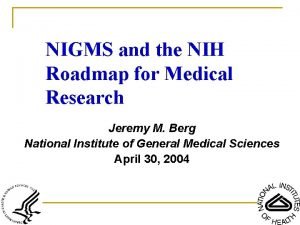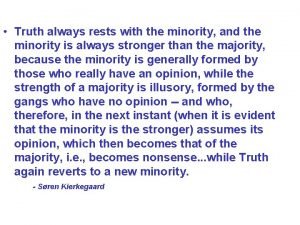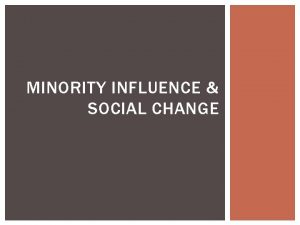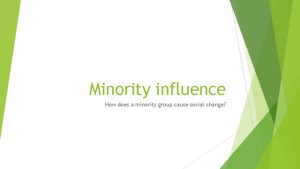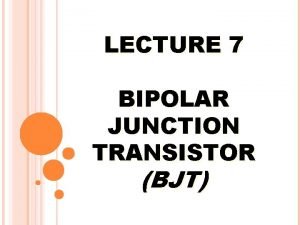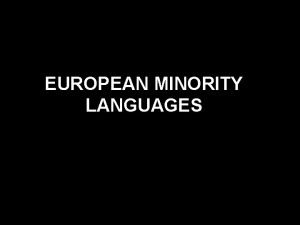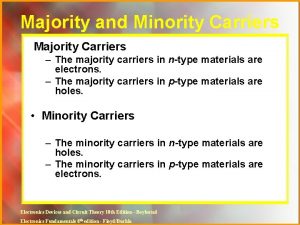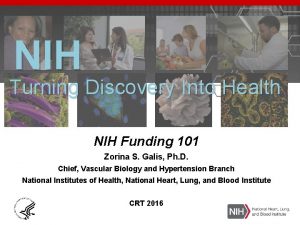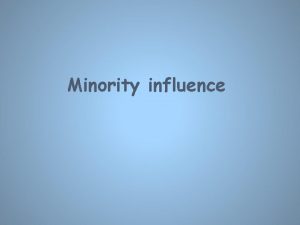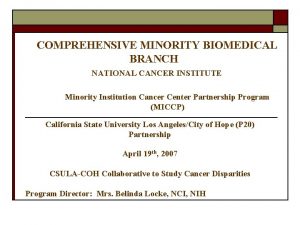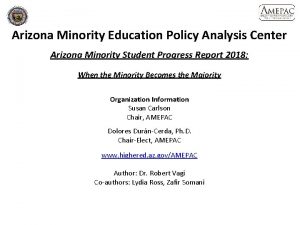Minority Health Research at NIH Nathan Stinson Jr


















- Slides: 18

Minority Health Research at NIH Nathan Stinson, Jr, Ph. D, MD Director, NIMHD Division of Scientific Programs 4 th Annual C. W. Bill Young Federal R&D Agency Workshop September 30, 2016

The Focus of NIMHD-supported Research The Translational Research Spectrum (From Blumberg, R. S. , B. Dittel, D. Hafler, M. von Herrath, and F. O. Nestle. 2012. Unraveling the autoimmune translational research process layer by layer. Nature Medicine 18(1): 35– 41)

The Focus of NIMHD-supported Research The Translational Research Spectrum Majority of NIH-funded Research

The Focus of NIMHD-supported Research The Translational Research Spectrum Majority of NIMHD-funded Research

NIMHD Science Vision: Moving Forward and Addressing Gaps (From Thomas SB, Quinn SC, Butler J, Fryer CS, Garza MA. Toward a fourth generation of disparities research to achieve health equity. Annu Rev Public Health. 2011; 32: 399 -416.

NIMHD Science Vision: Moving Forward and Addressing Gaps First Generation: Documenting disparities • Large body of research on disparities across populations and health conditions • Gaps: Disparities in understudied populations and subpopulations • Example of initiative to address gap: RFA-MD-15 -011, Building Population Health Research Capacity in the U. S. Affiliated Pacific Islands (U 24)

NIMHD Science Vision: Moving Forward and Addressing Gaps Second Generation: Explaining disparities • Numerous studies documenting associations (e. g. , SES and health) and identifying individual-level predictors of health status (e. g. , health literacy, insurance status) • Gaps: • Understanding how social determinants impact health through biological pathways • RFA-MD-15 -013, NIMHD Transdisciplinary Collaborative Centers for Health Disparities Research Focused on Precision Medicine (U 54) • PAR-16 -355, Social Epigenomics Research Focused on Minority Health and Health Disparities (R 01)

NIMHD Science Vision: Moving Forward and Addressing Gaps Second Generation: Explaining disparities • Gaps (cont): • Understanding population-level patterns of risk and resilience • Addressing Health Disparities Among Immigrant Populations (approved concept) • Understanding pathways of healthcare disparities • PAR-16 -221, Health Services Research on Minority Health and Health Disparities (R 01) • PAR-16 -391, Surgical Disparities Research (R 01)

NIMHD Science Vision: Moving Forward and Addressing Gaps Second Generation: Explaining disparities • Gaps (cont): • Understanding the interaction of multiple determinants and multiple levels across the lifecourse • Development of NIMHD research framework to guide research and evaluate research portfolios.

NIMHD Science Visioning: Moving Forward and Addressing Gaps Third Generation: Solutions to eliminate health disparities • Most intervention studies have focused on • Health promotion rather than elimination of disparities • Single health disparity populations • Individual knowledge, attitudes, and behavior • Gaps: • Interventions that have broad applicability across different health disparity populations • Example of initiative: RFA-MD-15 -012, Behavioral Interventions to Prevent HIV in Diverse Adolescent Men Who Have Sex with Men (U 01)

NIMHD Science Visioning: Moving Forward and Addressing Gaps • Third Generation: Solutions to eliminate health disparities • Gaps (cont): • Interventions that address structural determinants of health disparities • Retaining Youth and Young Adults from Health Disparity Populations in the HIV Treatment Cascade (approved concept) • Social Impact Bond Approaches to Eliminate Health Disparities (approved concept)

NIMHD Science Visioning: Moving Forward and Addressing Gaps • Third Generation: Solutions to eliminate health disparities • Gaps (cont): • Multi-level interventions • RFA-MD-15 -014, NIMHD Transdisciplinary Collaborative Centers for Health Disparities Research on Chronic Disease Prevention (U 54) • RFA-MD-16 -003, Engaging Youth and Young Adults from Health Disparity Populations in the HIV Treatment Cascade (R 01)

Selected NIMHD Science Advances

Stigma and High Risk Sexual Behavior among HIV+ African American Men Wagner, GJ; Bogart, LM; Klein, DJ; Green Jr, HD; Mutchler, MG; Mc. Davitt, B; Hilliard, C. Association of Internalized and Social Network Level HIV Stigma with High-Risk Condomless Sex Among HIV-Positive African American Men. Arch Sex Behav (2016): 45(6), 1347 -55. R 01 MD 003964, Medical Mistrust, Social Networks, and Disparities in HIV Care among Blacks (PI: Bogart) Examined relationships of internalized and social network HIV stigma and condomless sex in a sample of 125 African American HIV-positive men in Los Angeles. § Greater internalized HIV stigma and the perception that close members of the individual’s social network endorsed HIV stigma independently predicted higher levels of condomless sex. § Results highlight the importance of stigma reduction efforts to facilitate reduction of HIV risk behavior for individuals and their social networks.

HIV and Violence Risk Reduction in Latinas Mc. Cabe, BE; Gonzalez-Guarda, RM; Peragallo, NP; Mitrani, VB. Mechanisms of Partner Violence Reduction in a Group HIV-Risk Intervention for Hispanic Women. J Interpers Violence (2016): 31(13), 2316 -37. P 60 MD 002266, Center of Excellence for Health Disparities Research: El Centro (PI: Mitrani) Tested whether a culturally tailored group HIV-risk reduction intervention for Hispanic women (n=548) that reduced highrisk HIV behaviors also impacted levels of intimate partner violence. § Women receiving the intervention reported greater HIV riskrelated communication with their partner and lower levels of alcohol intoxication and intimate partner violence (IPV) than women in the control condition. § Findings show the importance of enhancing women’s communication with their partners as a means of reducing IPV, even in interventions not focused directly on IPV.

Sociodemographic Differences in Organ Donation Willingness Sehgal, N K R; Scallan, C; Sullivan, C; Cedeño, M; Pencak, J; Kirkland, J; Scott, K; Thornton, J D. The Relationship Between Verified Organ Donor Designation and Patient Demographic and Medical Characteristics. Am J Transplant (2016): 16(4), 1294 -7. P 60 MD 002265, Dissemination of Evidence-Based Health Disparity Interventions (PI: Seghal, Ashwini). Many studies on organ donation use self-reported willingness to donate, which may be subject to social desirability bias. This study used driver’s license and EHR data to identify correlates of donor willingness in 2, 070 primary care patients in a safety net medical system. § Driver’s license donor designation (46%) was lower than in studies of self-reported willingness (66%). § Individuals who were female, non-Hispanic white, English or Spanish speaking, employed, and privately insured were more likely to be designated as donors.

Early Childhood Disparities in Obesity Taveras, EM; Gillman, MW; et. al. Reducing racial/ethnic disparities in childhood obesity: The role of early life risk factors. JAMA Pediatr, 2013 Aug 1; 167(8): 731 -8. R 01 MD 003963, Racial/Ethnic Disparities in Early Life Risk Factors for Childhood Obesity (PI: Taveras, Elsie) Cohort study examining obesity risk factors during pregnancy, infancy, and early childhood in a cohort of 1116 mother-child pairs to understand the higher prevalence of obesity in African American and Hispanic children. • Infancy risk factors (e. g. , introduction of solid food before 4 months) and early childhood risk factors (e. g. , TV in child’s room at age 4) largely explained obesity disparities at age 7 • Pregnancy risk factors (e. g. , gestational diabetes, maternal depression) were unrelated to obesity disparities at age 7 • Findings suggest that efforts to reduce racial/ethnic disparities in obesity should focus on the prevention of early life risk factors.

Connect With Us Visit us online www. nimhd. nih. gov Connect with us on Facebook www. facebook. com/NIMHD Follow us on Twitter @NIMHD
 Nathan stinson
Nathan stinson How i met your mother hypnoweb
How i met your mother hypnoweb Hayley stinson
Hayley stinson Paula stinson
Paula stinson Vp managed care
Vp managed care Office of minority health resource center
Office of minority health resource center Nih
Nih Truth always rests with the minority
Truth always rests with the minority Define minority group
Define minority group Behaviours that enable a minority to influence a majority
Behaviours that enable a minority to influence a majority Define minority group
Define minority group Minority carrier diffusion equation
Minority carrier diffusion equation Minority carrier distribution in bjt
Minority carrier distribution in bjt Minority language
Minority language Sales and purchases ledger control accounts format
Sales and purchases ledger control accounts format Minority interest example
Minority interest example Define delimit demarcate administrate
Define delimit demarcate administrate Michigan minority contractors association
Michigan minority contractors association Electronic devices floyd 10th edition
Electronic devices floyd 10th edition






